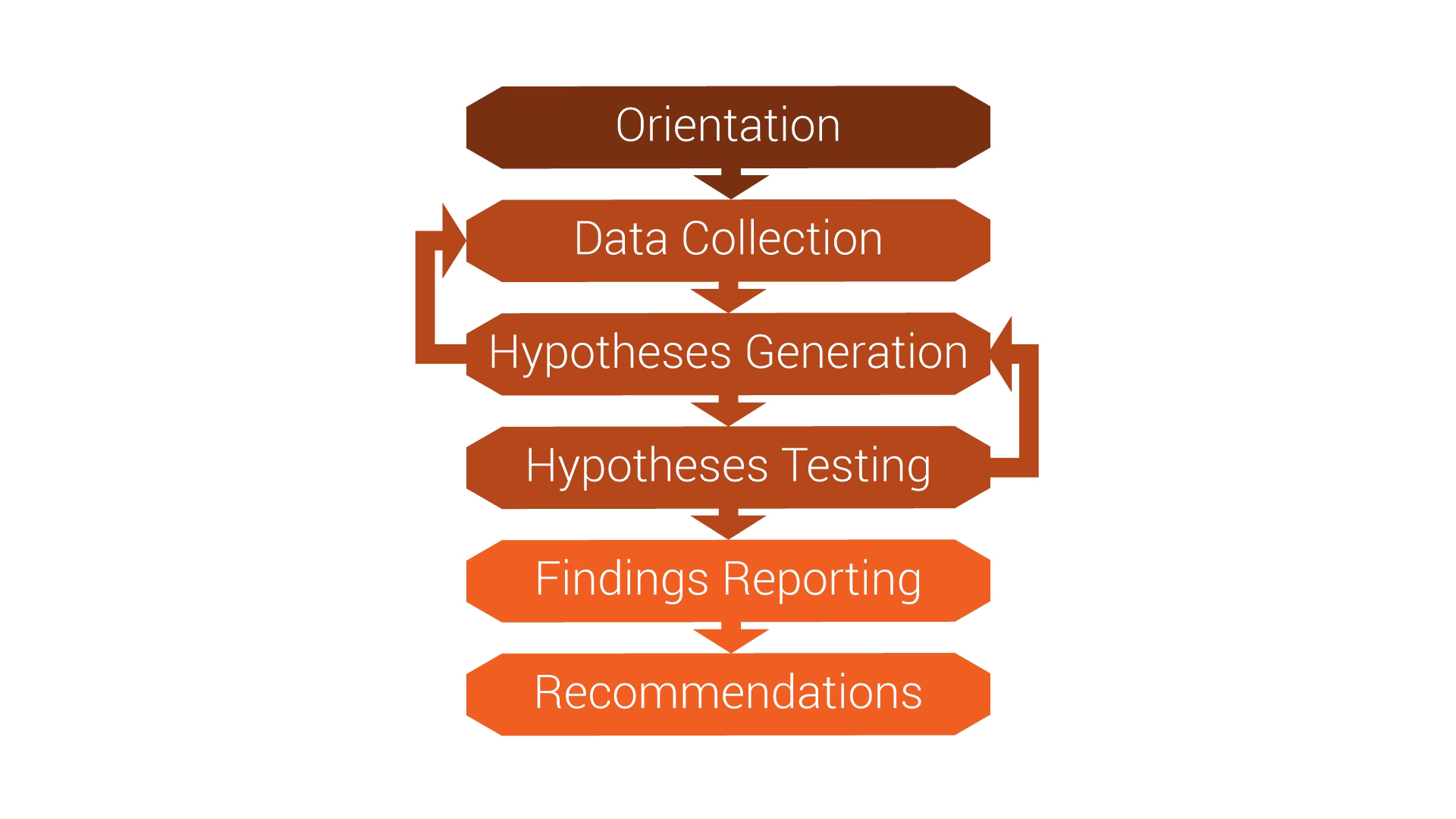Investigation goal & approach
Course subject(s)
5. Biomechanical Engineering
At the Femostad hospital an ERCP endoscope of the brand Flexinc and type ERCP12 appeared to have gotten infected and this infection appears to have persisted through several cleaning and use-cycles. The infected ERCP12 endoscope is registered at the Femostad hospital as Scope-X32. From now on, whenever we say “ERCP12 endoscopes“ we mean all Flexinc endoscopes of that type. Whenever we refer to the infected endoscope under investigation owned by the Femostad hospital, we use “Scope‑X32“.
To find out if, where on the scope and due to what cause the Pseudonomas Aeruginosa bacteria could have persisted in Scope-X32 over a series of use-cycles, while cleaning & disinfection was supposedly performed between all successive use-cycles.
Approach
The six-steps approach for Forensic Engineering Investigations will be used (Figure 1). In the orientation phase, some contextual information of the case was gathered, which led to a global understanding of the situation and a rough plan for the investigation:
– At the day of discovery of the outbreak, flushing samples of the working channels and swabbing samples of the tip of Scope X-32 showed presence of Pseudonomas Aeruginosa.
– All infected patients had the same strain of Pseudonomas Aeruginosa and had received diagnosis and/or treatment with Scope X-32.
– Endoscope cleaning staff complains that this type of scopes is hard to clean and that the brushes they are supposed to use, can’t reach some areas around the forceps elevator in the scope tip.
Based on these first findings, two hypotheses about the location where the bacteria were left behind were formed:
HL1) The bacteria were left behind in the working channel of Scope X-32.
HL2) The bacteria were left behind somewhere on or in the tip of Scope X-32.
In order to find out whether HL1 and/or HL2 were true and to find the cause of this bacterial persistence, if bacteria were indeed left behind, a plan was made to gather more data.

Figure 1: Schematic representation of the six-steps approach for Forensic Engineering Investigations.
Data collection
In order to fully understand the context in which the scope was used, data will be collected in three steps:
Step 1) Gathering knowledge about the working, construction, cleaning and disinfection of Flexinc ERCP12 ERCP-endoscopes. This is done in order to understand the technical system and its context in detail.
Step 2) Use a comparative audit (so here, auditing is an investigation tool) to investigate whether there were discrepancies between cleaning instructions given by the manufacturer and cleaning instructions used internally by the hospital.
Step 3) Use a destructive disassembling and bacterial sampling process (so here, disassembling and sampling are investigation tools) to search for damage, technical flaws and bacteria in the endoscope.
These three steps are further explained below.
STEP 1
You will gather knowledge about the ERCP-endoscope using a video that explains the parts of the endoscope and their functioning. The entire cleaning and disinfection cycle of ERCP-endoscopes will be explained in another video. The cleaning instructions provided by Flexinc en the cleaning instructions used by the Femostad hospital will be made available for download in section 5.3: Instruction & execution. The manual cleaning process of ERCP-endoscopes according to the Flexinc instructions will be demonstrated in a video.
Following the orientation (see Figure 1) and the results of Step 1, two new hypotheses about the cause of the outbreaks were formed:
HC1) Something was wrong with how the manual cleaning of the ERCP-endoscopes was done.
HC2) Something was wrong with the ERCP-endoscope itself.
STEP 2
You will be asked to find any discrepancies between the Flexinc instructions and the Femostad cleaning protocol for the manual cleaning of the ERCP-endoscopes (Instruction and Execution related causes). The pre-cleaning, automatic cleaning & disinfection, and drying steps of the cleaning and disinfection process are not further investigated, because these were all checked and confirmed to always have been performed properly.
STEP 3
Scope X-32 was disassembled during the Forensic Engineering Investigation. All parts of the scope tip were sampled to detect any Pseudonomas Aeruginosa bacteria left behind on or in the scope. The entire disassembling and sampling process and the results of the bacterial tests are described in a report that will be made available for download in section 5.3: Product & Instruction. You will be asked and guided (using a video) to find any Product related causes of the bacterial outbreaks.

Forensic Engineering: Learning from failures by TU Delft OpenCourseWare is licensed under a Creative Commons Attribution-NonCommercial-ShareAlike 4.0 International License.
Based on a work at https://ocw.tudelft.nl/courses/forensic-enginee…earning-failures/.



